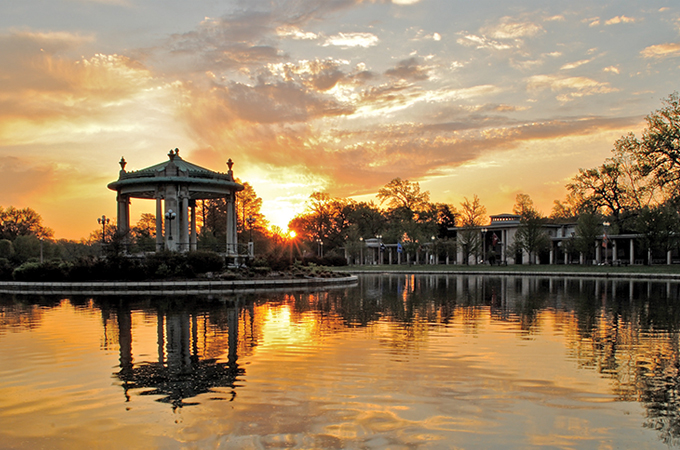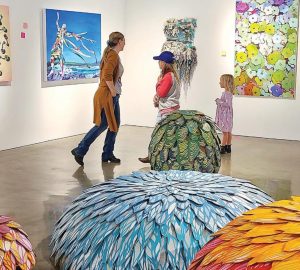Think of all the wonderful urban parks from coast to coast you’ve visited over the years, and chances are when it comes to naming the best of them, you’ll always come back to your favorite, the jewel of The Lou: Forest Park (pictured above). Well, USA Today surveyed four national experts on urban planning—top execs at The Trust for Public Land, the National Parks & Recreation Association, the American Planning Association and the Project for Public Spaces—to find the 20 best urban parks in the country. Then a popular vote by readers ranked the top 10, with our very own Forest Park squeaking by Klyde Warren Park in Dallas to snag the top spot. Central Park in NYC was No. 10, surprisingly, with all the hype it gets and despite (or maybe because!) the fact that one of the expert rankers worked for Mayor Michael Bloomberg in the Big Apple’s parks department for 11 years. Prospect Park in Brooklyn was No. 8, but no California city parks made the final cut, including Golden Gate in San Francisco and Balboa Park in San Diego. What’s so great about ‘FoPo’ (as if we have to tell you)? One of the largest U.S. city parks, it is more than 1,300 acres in area, about a third larger than Central Park. Not to mention, many of the city’s greatest attractions are situated on the grounds and most, like Saint Louis Zoo, feature free admission. (But just try finding free parking for the attractions—nevermind, let’s not be curmudgeonly during this moment of glory.)
st. louis – Trumpet player Clark Terry was born in the Carondelet neighborhood of St. Louis. And he is the subject of the mural on the side of a building along South Broadway (7714, to be exact), which was dedicated earlier this month with great fanfare. Yes, there were trumpets to celebrate the jazz giant in the composite featuring three images of Terry, two of him blowing his horn, one in smiling repose. Terry’s mural is the seventh of 10 planned for that stretch of Broadway, between Bellerive Park and the River Des Peres in Carondelet, a town annexed by St. Louis in the late 1800s. Others commemorate early life along the river. One is more pop; a startling orange background on a corrugated steel surface, two eyes widely staring. Another, of ripening vegetables, is on the wall next to a community garden. So, just how big a deal was Terry? He played with Count Basie, Duke Ellington, Dizzy Gillespie, Quincy Jones and others. He is credited with mentoring the likes of Miles Davis and Wynton Marsalis, legendary players in their own right. For the dedication, Champian Fulton played with her touring jazz quartet; she is the daughter of Stephen Fulton, a jazz horn player who was good friends with and studied under Terry for many years. Terry, named a jazz master by the National Endowment for the Arts in 1991, was given the Grammy Lifetime Achievement Award in 2010. He was 94 when he passed away in 2015.
clayton – Kenneth and Nancy Kranzberg have done it again: The major arts patrons are flexing their philanthropic muscle on behalf of Washington U. The Kranzbergs plan to make a $2 million gift to support initiatives for the University Libraries and the Sam Fox School of Design & Visual Arts, including (and Get Set for Plenty More Capitalization of Proper Names):
• $950,000 for the Modern Graphic History Library in the University Libraries, which will be named in honor of Douglas Dowd, professor of communication design in the Sam Fox School and of American culture studies in Arts & Sciences;
• $800,000 for the construction of the Anabeth and John Weil Hall at the Sam Fox School;
• $200,000 for the Ken and Nancy Kranzberg Fund in the Mildred Lane Kemper Art Museum, in honor of Sabine Eckmann, the William T. Kemper director and chief curator; and
• $50,000 for the Gaylord Music Library, part of the university library system, in honor of Dolores Pesce, the Avis Blewett Professor of Music in Arts & Sciences.
BTW, the Kranzbergs’ continuing financial generosity to Washington University is matched only by their contributions of talent, community-wide, in
volunteer leadership roles. (Details would probably spill over into the second half of our magazine .)
town & country – The StL has hit a home run with its aptly named Musial Awards. The National Association of Sports Commissions (NASC) recently recognized the Musial Awards as the Locally Created Event of the Year. The award was presented to the St. Louis Sports Commission at the NASC’s annual Sports Event Symposium in Grand Rapids, Michigan. Since 2005, our Sports Commission has produced the awards, which honor Stan Musial’s legacy by celebrating the greatest moments and stories of sportsmanship in North America. Recent honorees include golf legend Arnold Palmer, baseball Hall-of-Famer Joe Torre, Little League World Series star Mo’ne Davis and Turner network sportscaster Ernie Johnson. Are the Musial Awards a big fish in a small pond? Hardly. NASC is the leading trade organization for the sports tourism industry, with 750 member organizations representing more than 350 cities. And no one has to tell us how nuts The Lou is about sports. Nor about one of its favorite sons, Stan Musial, who is known as much for his character as his batting average. Honorees are recognized for extraordinary displays of sportsmanship that represent the best in sports and humanity. This inspirational night occurs annually at the historic, 3,000-seat Peabody Opera House in downtown St. Louis and airs as a primetime television special on our NBC affiliate, KSDK-TV. Presented by Maryville University, the 2016 Musial Awards take place Nov. 19. Mayhaps by then we’ll have yet another World Series championship to celebrate?
university city – The monarch is the queen of butterflies. U. City has paid homage to this beautiful insect through one of its Citizen Volunteer Corps (CVC) groups by installing a monarch garden on Vernon Avenue, to the west of the dog play area. The city will be installing a second garden this spring at the Sutter-Meyer Farmhouse. This is good, because millions upon millions of monarchs (maybe billions, but I lost count last year at 54) migrate south from Canada to Mexico in the fall and northward in the spring. U. City has undertaken a challenge put forth for mayors nationwide to establish habitats for the bugs as they flutter by. Citizens, of course, can work on their own habitats. Plants that attract monarchs will be available at the U. City in Bloom plant sale slated for Saturday, April 30, and Sunday, May 1.










